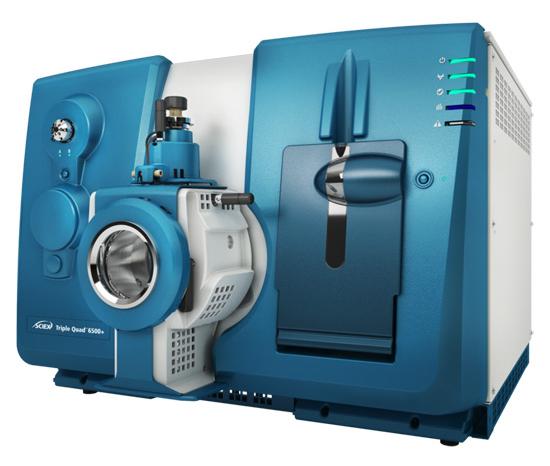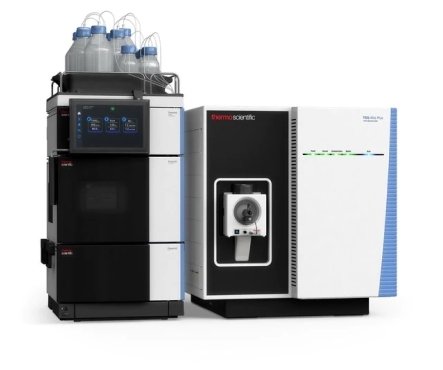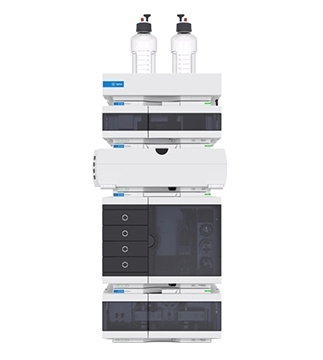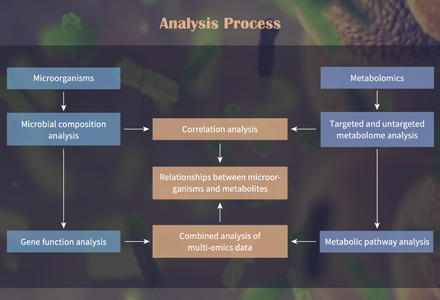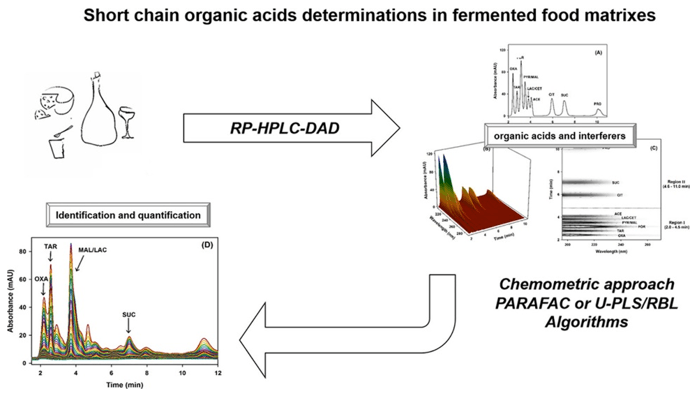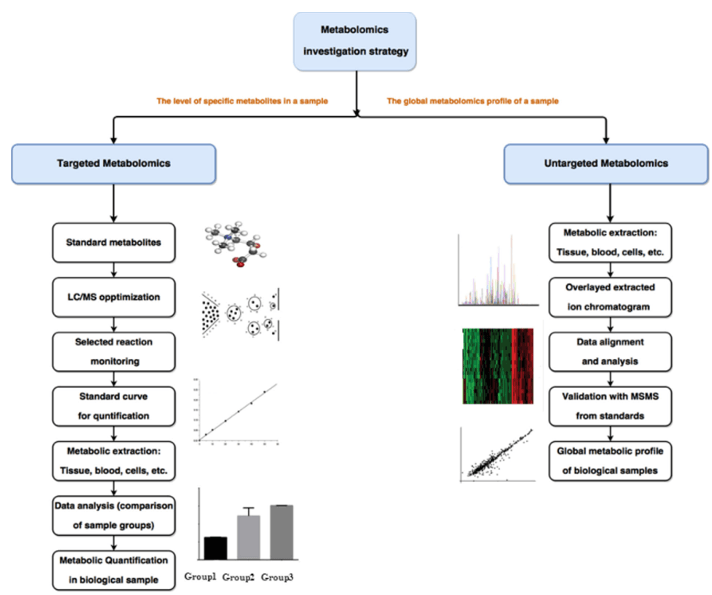Citric Acid Analysis Service – High-Precision Quantification & Metabolic Profiling
Submit Your Inquiry- Service Details
- FAQ
- Publications
Why Citric Acid Analysis Matters for Your Project
Citric acid is a central metabolite in the tricarboxylic acid (TCA) cycle, linking carbohydrate, fat, and protein metabolism. Its concentration reflects metabolic fluxes, energy balance, and redox status across diverse biological systems. In plants, citric acid levels influence flavor, acidity, and nutrient uptake. In microbial and fermentation studies, it serves as a key performance indicator for production optimization. For industrial applications, citric acid quantification ensures quality control in food, beverage, and biochemical manufacturing processes.
Accurate, reproducible citric acid measurement is essential to:
- Map central carbon metabolism in biochemical and systems biology research.
- Characterize plant organic acid profiles for breeding and post-harvest quality assessment.
- Monitor fermentation yield and purity in bioproduction workflows.
- Support formulation stability testing for food, nutraceutical, and beverage industries.
What Problems We Solve for Our Clients
Service Scope — Creative Proteomics Citric Acid Analysis
Creative Proteomics offers high-precision, matrix-validated citric acid quantification for a wide variety of sample types, covering biological, food, beverage, fermentation, and industrial applications. Our analytical workflows are selected and optimized for each sample type, ensuring accurate, reproducible, and context-relevant results. Services can be provided as stand-alone testing or integrated into organic acids and TCA cycle metabolite panels for broader interpretation.
Service Items Include:
- Targeted Citric Acid Quantification via LC-MS/MS with 13C-labeled internal standards
- Isomer Resolution between citrate and isocitrate for enhanced specificity in complex matrices
- Co-Acid Profiling for malic, succinic, tartaric, lactic, acetic, fumaric, gluconic acids
- Citrate:Isocitrate Ratio Calculation for authenticity checks, metabolic state assessment, or pathway analysis
- Matrix-Matched Extraction for biological samples (biofluids, tissues, plants, microbial cultures) and non-biological matrices (beverages, syrups, fermentation broths, industrial solutions)
- Low-Volume High-Sensitivity Analysis for scarce samples such as CSF, microdissected tissues, and limited fermentation trial batches
- Orthogonal Confirmation with secondary analytical platforms (HPLC-UV, Ion Chromatography, GC-MS) upon request
- Optional Isotopologue Tracing for ^13C metabolic flux studies in both biological and fermentation systems
- Comprehensive QC-Integrated Reporting with chromatograms, QC summaries, and traceable metadata
Citric Acid Assay — Analyte List & Detection Scope
| Category | Analyte | Description / Application |
| Primary Target | Citric Acid (Citrate) | Key TCA cycle metabolite; quantified as free acid or anion equivalent |
| Isomers | Isocitric Acid | Isomer-resolved quantification; important for authenticity verification |
| TCA Cycle Related | α-Ketoglutaric Acid | TCA intermediate; metabolic and fermentation studies |
| Succinic Acid | Energy metabolism / fermentation indicator | |
| Fumaric Acid | TCA intermediate | |
| Malic Acid | Found in fruits, plant tissues; resolved in targeted methods | |
| Oxaloacetic Acid | TCA cycle terminal intermediate; flux analysis | |
| Other Organic Acids | Tartaric Acid | Found in grapes, wine, beverages |
| Lactic Acid | Marker for fermentation and anaerobic metabolism | |
| Acetic Acid | Secondary fermentation product; QC relevance | |
| Gluconic Acid | Oxidative metabolism indicator | |
| Ascorbic Acid | Quality and nutritional marker in food and beverages | |
| Optional Metrics | Citrate:Isocitrate Ratio | Authenticity checks, pathway analysis, process monitoring |
| Co-Acid Profile | Comprehensive organic acid spectrum | |
| Isotopologue Tracing | ^13C tracer analysis for metabolic flux | |
| Salts & Derivatives | Sodium/Potassium Citrates | Common in formulations and industrial samples |
Why Choose Our Citric Acid Analysis Service: Key Advantages
Citric Acid Assay Technical Details & Coverage
Analytical Platforms
- LC-MS/MS (ESI−, MRM) — Primary platform for low-abundance or complex matrices; supports ^13C-citrate internal standards, isomer separation, and micro-volume detection.
- HPLC-UV (Ion-Exclusion) — Robust and cost-effective for clean aqueous samples such as beverages, fermentation supernatants, or simple extracts.
- GC-MS (Derivatized) — Used for legacy data continuity or volatile derivative workflows.
Detection Performance
- LOD: ~10 ng/mL (matrix-dependent) via LC-MS/MS with isotope-labeled internal standards
- Dynamic Range: μg/L to % w/w or w/v, platform-specific
- Isomer Resolution: Complete separation of citrate and isocitrate to avoid misquantification
- Matrix Effect Control: SPE cleanup, dilution linearity checks, post-extraction spike recoveries
How Our Citric Acid Analysis Works — Step-by-Step Process
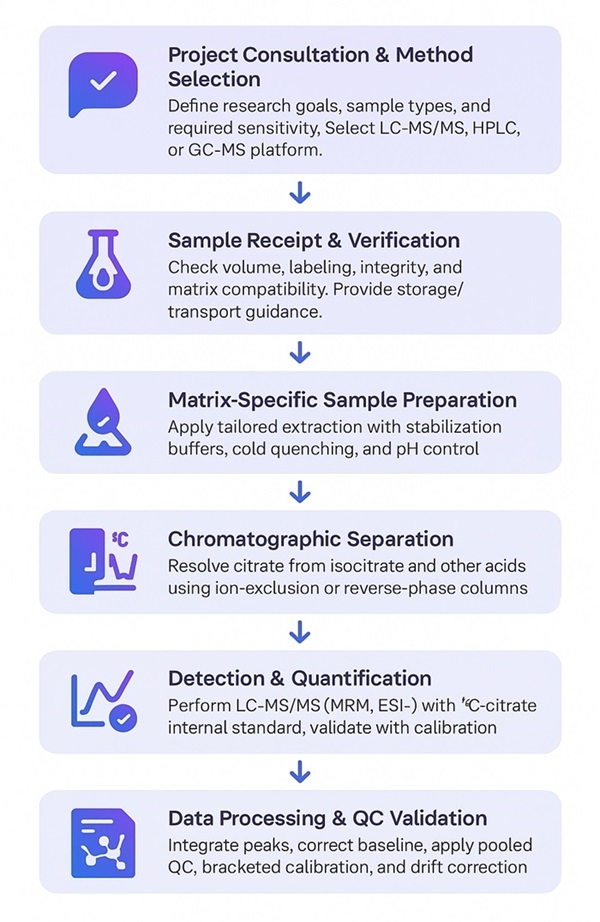
How to Prepare Your Samples for Citric Acid Quantification
| Sample Type | Minimum Volume / Weight | Container | Preservation / Handling | Special Notes |
|---|---|---|---|---|
| Plasma / Serum | ≥ 100 µL | EDTA or heparin tubes (avoid citrate tubes) | Centrifuge within 30 min of collection; aliquot and store at −80 °C | Avoid repeated freeze–thaw cycles |
| Urine | ≥ 500 µL | Sterile, acid-washed polypropylene tubes | Store at −80 °C; optional acidification to pH < 3 for stability | Record collection time and any additives |
| CSF | ≥ 50 µL | Low-binding microcentrifuge tubes | Freeze immediately at −80 °C | Handle promptly due to low abundance |
| Tissues | ≥ 50 mg | Pre-labeled cryovials | Snap-freeze in liquid nitrogen; store at −80 °C | Provide tissue type and weight |
| Cell Pellets | ≥ 1×10^6 cells | Cryovials | Wash with cold PBS; snap-freeze; store at −80 °C | Indicate cell count and culture conditions |
| Plant Material | ≥ 100 mg (fresh weight) | Foil or cryovials | Freeze immediately; store at −80 °C; protect from light if pigment-rich | Specify tissue type and fresh/dry weight |
| Beverages / Juices | ≥ 10 mL | Clean, acid-free plastic or glass bottles | Refrigerate for short-term (<48 h); freeze at −20 °C for long-term | Degas carbonated drinks before sealing |
| Fermentation Broth | ≥ 10 mL | Sterile, acid-washed containers | Store at −20 °C or −80 °C; filter or centrifuge to remove solids if required | Note fermentation stage or sampling point |
| Industrial Water / CIP Samples | ≥ 50 mL | Clean, acid-free HDPE bottles | Store at 4 °C for short-term (<24 h); freeze for longer storage | Avoid contamination from sampling tools |
| Sample Type | Minimum Volume / Weight | Container | Preservation / Handling | Special Notes |
| Plasma / Serum | ≥ 100 µL | EDTA or heparin tubes (avoid citrate tubes) | Centrifuge within 30 min of collection; aliquot and store at −80 °C | Avoid repeated freeze–thaw cycles |
Citric Acid Testing — Deliverables & Reporting
- Quantitative results for citric acid in your preferred units (e.g., μM, mg/L, %, etc.)
- Optional related analytes such as isocitric, malic, succinic, fumaric, tartaric, lactic, acetic, and gluconic acids
- Citrate:isocitrate ratio or other requested derived metrics
- Result tables ready for direct use in QC, research, or process monitoring
- Chromatograms or spectra with labeled peaks for confirmation
- Brief method summary to outline the analytical platform and key QC indicators
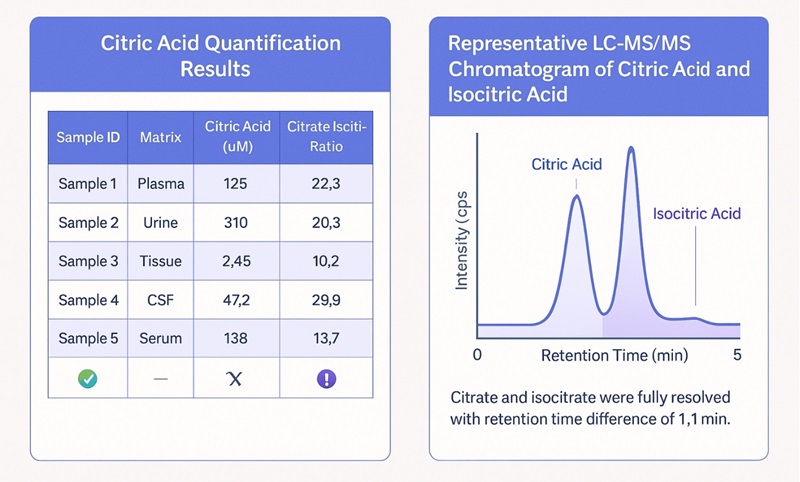
Can you analyze citrate in both free acid and salt forms?
Yes. Our methods can quantify citric acid either as free acid or as anion equivalent. When salts (e.g., sodium or potassium citrate) are present, we can convert the result to citric acid equivalent if required.
Is it possible to detect both intracellular and extracellular citrate in cell culture studies?
Yes. We offer workflows for both intracellular extraction (e.g., from cell pellets) and extracellular quantification (e.g., from culture media), enabling comparison of citrate pools in metabolic studies.
How do you ensure accurate results in pigment-rich plant samples or colored beverages?
We apply matrix-specific cleanup procedures such as solid-phase extraction (SPE) or pigment/phenolic removal to minimize interference, combined with isomer-resolving chromatography.
Can the assay be integrated into a broader metabolomics workflow?
Yes. Citric acid analysis can be performed as part of a targeted organic acids panel or TCA cycle metabolite panel, and we can align sample preparation protocols for multi-analyte workflows.
What is the minimum number of samples you can process?
We accept both small pilot batches and large-scale projects. For very small projects, we recommend discussing sample type and concentration range to optimize the workflow.
Do you provide citrate:isocitrate ratio as a standard metric?
This ratio is available on request and is especially valuable for authenticity verification, metabolic state assessment, and certain fermentation quality checks.
Can you perform isotopologue analysis for 13C tracing studies?
Yes. We offer isotopologue distribution reporting for citrate when 13C-labeled substrates are used, providing insight into metabolic flux through the TCA cycle.
How do you handle potential co-elution of citrate with other organic acids?
Our LC-MS/MS methods and ion-exclusion chromatography are optimized for isomer resolution, and we can confirm results using orthogonal platforms if needed.
Are your methods suitable for highly diluted industrial water or cleaning validation samples?
Yes. We can detect citrate in low-concentration aqueous samples and apply pre-concentration or ion chromatography methods when required.
High Levels of Oxidative Stress Early after HSCT Are Associated with Later Adverse Outcomes
Cook, E., Langenberg, L., Luebbering, N., Ibrahimova, A., Sabulski, A., Lake, K. E., ... & Davies, S. M.
Journal: Transplantation and Cellular Therapy
Year: 2024
Badoni, S., Pasion-Uy, E. A., Kor, S., Kim, S. R., Tiozon Jr, R. N., Misra, G., ... & Sreenivasulu, N.
Journal: Proceedings of the National Academy of Sciences
Year: 2024
The Brain Metabolome Is Modified by Obesity in a Sex-Dependent Manner
Norman, J. E., Milenkovic, D., Nuthikattu, S., & Villablanca, A. C.
Journal: International Journal of Molecular Sciences
Year: 2024
Kanamaru, H., Zhu, S., Dong, S., Takemoto, Y., Huang, L., Sherchan, P., ... & Zhang, J. H.
Journal: Stroke
Year: 2024
Burchard, P. R., Ruffolo, L. I., Ullman, N. A., Dale, B. S., Dave, Y. A., Hilty, B. K., ... & Hernandez-Alejandro, R.
Journal: Hepatology Communications
Year: 2024
Tamanna, N., Mojumder, A., Azim, T., Iqbal, M. I., Alam, M. N. U., Rahman, A., & Seraj, Z. I.
Journal: Plant‐Environment Interactions
Year: 2024
Mirzapoiazova, T., Tseng, L., Mambetsariev, B., Li, H., Lou, C. H., Pozhitkov, A., ... & Salgia, R.
Journal: iScience
Year: 2024
Gajardo, H. A., Morales, M., Larama, G., Luengo-Escobar, A., López, D., Machado, M., ... & Bravo, L. A.
Journal: Planta
Year: 2024
A personalized probabilistic approach to ovarian cancer diagnostics
Ban, D., Housley, S. N., Matyunina, L. V., McDonald, L. D., Bae-Jump, V. L., Benigno, B. B., ... & McDonald, J. F.
Journal: Gynecologic Oncology
Year: 2024
Glucocorticoid-induced osteoporosis is prevented by dietary prune in female mice
Chargo, N. J., Neugebauer, K., Guzior, D. V., Quinn, R. A., Parameswaran, N., & McCabe, L. R.
Journal: Frontiers in Cell and Developmental Biology
Year: 2024
Proteolytic activation of fatty acid synthase signals pan-stress resolution
Wei, H., Weaver, Y. M., Yang, C., Zhang, Y., Hu, G., Karner, C. M., ... & Weaver, B. P.
Journal: Nature Metabolism
Year: 2024







